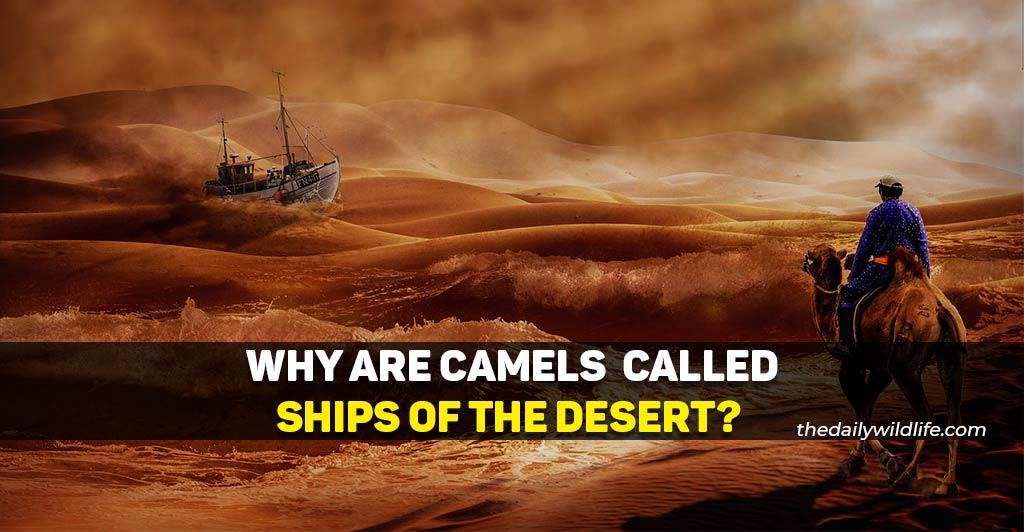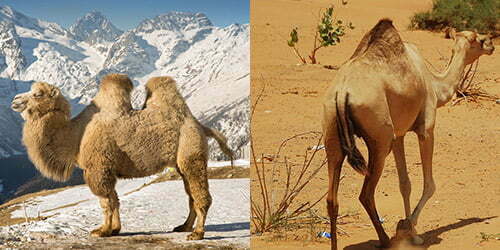Camels are called ships of the desert, because similarly to ships gliding over the water, camels glide over the desert sand. And like ships, camels transport goods and people with ease. Calling a camel a “ship of the desert” is a figure of speech.
A boat is surrounded by the vast sea of water; a camel is surrounded by the vast sea of desert sand.
A camel has been the only means of transportation in the deserts of Africa, Asia, and Australia for hundreds of years.
Because of their ability to carry heavy weight in the desert, humans have been using camels to transport goods on the Silk Road. The Silk Road was a network of trade routes that connected China and the Far East with the Middle East and Europe.
And as ships float through the seas, oceans, and other deep waterways, so have camels “sailed” through the desert. They carried silk, textile, gold, jade, fur, ceramics, bronze, books, spices, medicines, and other luxury goods. No wonder people value camels so highly.
A typical caravan had between 500 and 12,000 camels moving from one place to the other.
Australia is a place famous for kangaroos. Yet, because of their ability to survive extreme temperatures, camels were the animals used for transport there for many years.
Back in the 19th century, British pioneers used camels to explore the hot and dry Outback region in Australia. This stopped in the early 20th century when camels got replaced by motorized vehicles and rails.

Adaptations That Allow The Camels To Be Called The Ships Of The Desert
A dromedary camel has one hump, while a Bactrian camel has two. The hump consists of fatty tissue and can be used as food and water. The hump allows the camel to survive for several weeks without eating food or drinking water. When a camel has not been eating for a long time, its hump will become limp and fall to one side.

Camels might also be compared with ships because of the huge amount of water these animals can drink. It is said that a thirsty camel can drink over 20 gallons of water (75 liters) in a couple of minutes.
Camels also have long legs and thick, padded feet. They prevent the camels from sinking into the sand, protect the feet from getting burned, and allow them to move easily throughout the desert.
They have flexible nostrils that can close at will. During sandstorms, nostrils prevent sand from getting inside the animal.
Long eyelashes and thick and coarse eyebrows protect the eyes from the hot sun. They also prevent sand and other particles from getting inside the eye. Camels have a third eyelid (humans only have 2) that works like a windshield wiper. It removes any particle that got into the eye of the animal.
The “ship” of the Arabian and North African deserts, the one-humped dromedary camel, has a light-colored and thick fur. It reflects sun rays and prevents the camel from burning and overheating. During the night, desert temperatures can drop to around 25°F (about -3.9°C). Thick fur keeps the camel warm and protects it from freezing.
Camels also have small and furry ears. They allow them to hear well and also prevent sand from getting inside the animal.

To be able to cross the hot desert, camels will rarely sweat. They will increase their body temperature on purpose to sweat less and save water.
Camels will also eat almost any plant they find in the desert. Scientists discovered that a camel will eat around 80% of plants that are available in an area.
Camels have flexible lips, strong teeth, and tough leathery mouths. Because of that, camels can eat prickly desert plants like cactuses with six-inch-long needles, without getting injured.
These ships of the desert are very strong animals. They can carry a 600-pound heavy load (270 kg) for 60-70 miles per day (95-110km). They can also walk 12h straight and go without water for over 15 days.
And just like water waves rock a ship, so do camels rock back and forth when they’re walking. Some say that riding a camel can make you seasick.
Because of this, camels are used to cross the desert, just as ships are used to cross the seas and oceans. Without the ship, you cannot cross the sea. Without the camel, you cannot pass the desert.
Read More: A list of well-known camels in history
3 Points On Why Camels Are Called Ships Of The Desert
- Like ships, camels carry weight and passengers in the desert. Camels can carry over 600-pound heavy cargo.
- Because of their long legs and wide feet, camels glide across the desert without a problem.
- Similar to ships on long voyages, camels can survive several-week-long trips without food and water thanks to their humps.
TL;DR – Why Are Camels Called Ships Of The Desert?
A camel is called a ship of the desert because, for a long time, it was the only means of transport in the desert. Camels carry goods and passengers across the desert as a ship does across the sea. Because of their hump, long legs, wide feet, thick fur, and other adaptations, camels can move easily on sand.
You can use this article to easily write any “camel ship of the desert” essay you have, whether it is for class 3, 4, or 7.
Camels are also known as beasts of burden. Here’s why.
We hope you found the article interesting and that we answered the question “why are camels called ships of the desert”, and explained its meaning.
References
[1] Box, Jayne Brim, et al. “The impact of feral camels (Camelus dromedarius) on woody vegetation in arid Australia.” The Rangeland Journal 38.2 (2016): 181-190.